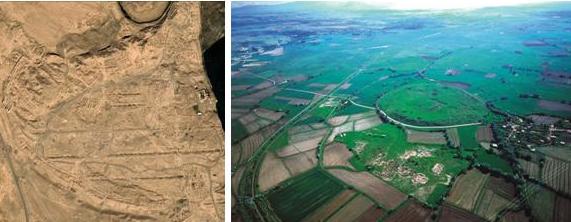Anytime I read about the Old Assyrian trading colonies, I find myself wondering about the links between Aššur and Kaneš. Being two cities in quite different landscapes, Aššur’s yellow-sand surroundings don’t exactly look like the fertile plain that enclose Kaneš.

Still, these two centers are always reflected to have developed a special relationship that was not duplicated between two other cities, even on different levels of intimacy. The reasons behind this partnership are most probably very complicated, and is not at all transparent to the modern viewer. Thus, I don’t aim to provide a comprehensive “answer” to the question at hand (and I don’t think that one exists), but I will just work on a few musings.
Most of the trade relationship between Aššur and Kaneš are known through textual evidence mainly found in the kārūm of Kültepe and most documents date from a single generation of merchant activity (Barjamovic 2010). Thus, the first obvious theory might be that pairings of this kind between different cities (or maybe between Aššur and another city) indeed existed, but archaeology has not been able to unearth such other archives yet.
Another probable explanation might be that Aššur and Kaneš exactly had what each other needed, and this was a mutually beneficial relationship for both. However, we know that not all of the materials that came into Kaneš came from Aššur itself. Within the huge amounts of materials traded back and forth between these cities were included textiles from Babylonia as well as tin from the further northeast of Aššur. Although not much is known about the nature of the relation between Aššur and Babylonia per se, textual evidence points out to the existence of a network (Barjamovic 2010). This situation demands an explanation more in the vein of trading hubs rather than production centers for both Aššur and Kaneš, and locates them in a central position for the control and distribution of trade goods in a large hinterland.
Another explanation might rest on the socio-political environment in Kaneš. Barjamovic (2010: 5) discussed how the Assyrian communities in the kārū and wabartū retained their judicial and financial institutions independent from the community in which they were settled. Thus, one can argue that Aššur was aware that Kaneš had a hospitable atmosphere suitable for that type of endeavour, and selected it as a trade partner. Still however, there are reasons and results missing from this picture. All what was discussed above allures to top-down explanations in which “elites” or “governors” in Aššur and Kaneš were making rational decisions for a pre-determined outcome. On the other hand, the textual evidence points to a “state-free” trade relationship between certain individuals, who had families in both cities. Nowhere are the “kings” mentioned as contributors or even as overseers, and their position within this network is uncertain (Berdan 1989). Thus, the relationship between these two cities might have such personal reasons owing to the individual relationships between individuals, which then turned into a more organized endeavour.
Such a viewpoint may also account for the absence of Cilicia and Syria in the network (Barjamovic 2010). If the reciprocity between Aššur and Kaneš was on a more individualistic level, such a knowledge / opportunity might have not been created with another city in Syria or Cilicia. Kaneš was the first kārūm to be established in Anatolia and the gateway for the rest. On the other hand, it was only for two generations (30-40 years) that such intense relationship took place. It can well be argued that this is just enough time for the pass of social memory and thus individual acquintances, in the vein as something important for establishing and sustaining trade relationship.
At this point, the discussion comes back to what Berdan (1989: 83) was putting forward in terms of trade relationships. Citing from Polanyi, he argued that there are three models of trade (gift exchange, redistribution and market exchange). In fact, Berdan also argues for three different relationships that might include/result in trade: peer relations, a central authority capable of storing and redistributing the goods, or monetary/exchange relationships. In the specific example of Aššur and Kaneš, we might be dealing with a web of peer relations, not including the so-called elites/administrators on both sides of the game, thus making such an interpretation easier to fall out of favor. A network approach, as also mentioned by Barjamovic (2008), is thus needed. However, at least in terms of the specific example of Aššur and Kaneš, these networks should be constructed on multiple scales while including individualistic records. Thus, maybe we can end up with models of “state-free” trade, that are distilled through the perspective of more bottom-up perspectives.
Works Cited:
Berdan, Frances F.; 1989.“Trade and markets in precapitalist states,” in Economic anthropology. StuartPlattner (ed). StanfordUniversity Press, 78-107.
Veenhof, Klaas R. and Jesper Eidem; 2008. Mesopotamia: The Old Assyrian Period. Academic Press Fribourg. Read 147-182.
Parkins, Helen; 1998.“Time for Change? Shaping the Future of Ancient Economy,” in Trade, traders and the ancient city. H. Parkins& C. Smith (eds.), Routledge: London, 1-15.
Kulakoglu, Fikri; 2011. "Kültepe-Kanes: A Second Millennium BCE trading center on the central plateau" in Oxford Handbook of Ancient Anatolia. S R. Steadman and G. McMahon (eds). Oxford University Press, 1012-1030.
Barjamovic, Gojko; 2008.“The Geography of Trade – Assyrian Colonies in Anatolia c. 1975 – 1725 B.C. and the Study of Early Interregional Networks of Exchange” In Anatolia and the Jazira during the Old Assyrian Period. J.G. Dercksen (ed.) (PIHANS 111), Leiden: Nederlands Instituutvoor het NabijeOsten, 87-100.
Bajramovic, Gojko; 2010. A Historical Geography of Anatolia in the Old Assyrian Colony Period. (CarstenNiebuhrInstitute Publications 38). Copenhagen: Museum Tusculanum Press.
